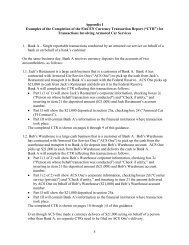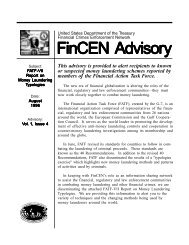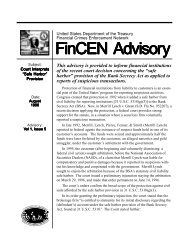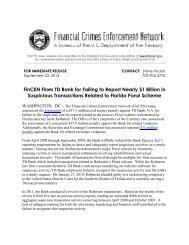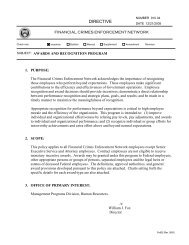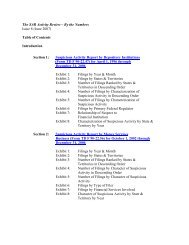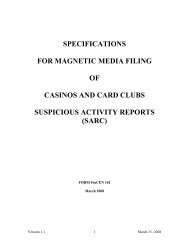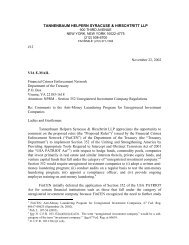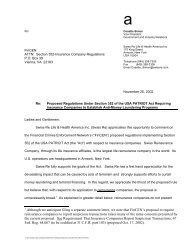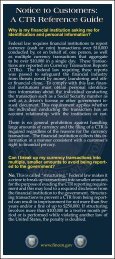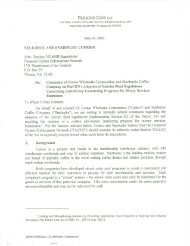The SAR Activity Review Issue 12 - FinCEN
The SAR Activity Review Issue 12 - FinCEN
The SAR Activity Review Issue 12 - FinCEN
You also want an ePaper? Increase the reach of your titles
YUMPU automatically turns print PDFs into web optimized ePapers that Google loves.
0<br />
Unlicensed money transmitters (businesses engaged in the money transmission<br />
business without a license where such licensing is required and without<br />
having established a valid authorized representative relationship) face no such<br />
requirements from state level regulators and are a significant <strong>SAR</strong> compliance<br />
risk. Unlicensed money transmitters face none of the state licensing barriers to<br />
entering business. Unlicensed money transmitters are a substantial compliance<br />
risk to our financial system and our society in general.<br />
Certainly, within the wide array of licensed money transmitters there are varying<br />
degrees of <strong>SAR</strong> compliance risk. But the fact that a money transmitter possesses<br />
a state issued license is a significant indicator of reduced compliance risk.<br />
Different types of state-licensed money transmitters face different types of <strong>SAR</strong><br />
compliance issues. Medium-to-large state licensed money transmitters have<br />
sophisticated software compliance systems used to detect patterns of suspicious<br />
activity in their enormous databases of transmission-related information.<br />
<strong>The</strong>se are almost exclusively back office systems as the medium to large state<br />
licensed money transmitters have very little face-to-face contact with customers.<br />
<strong>The</strong> customer interaction is almost exclusively conducted by the authorized<br />
representative of the licensed money transmitter. Accordingly, it is entirely<br />
appropriate and expected that the authorized representative will be required<br />
to, and will, file <strong>SAR</strong>s concerning suspicious activity that is apparent due to the<br />
particularities of any specific transaction.<br />
Authorized representatives are often not engaged in money transmission as<br />
their main line of business, so they will not usually be as sophisticated as the<br />
licensed money transmitter which they represent. This lack of sophistication<br />
will not stop them from recognizing suspicious activity in the interaction with<br />
the customer. Suspicious activity that occurs in the actual transaction is largely<br />
obvious and apparent.<br />
Smaller state-licensed money transmitters face a different set of problems. <strong>The</strong>y<br />
are often burdened with detecting both the face-to-face related suspicious activity<br />
and the more nuanced suspicious activity detectable through transaction review<br />
after the face-to-face customer exchange is concluded. After a certain level of<br />
volume is achieved, back office suspicious activity detection will be very difficult<br />
without either a sophisticated compliance software system or substantial resources<br />
to devote to the project. This is a significant problem for small money transmitters<br />
as the cost and difficulty of obtaining and maintaining a compliance software<br />
system may be too great for their business to bear. This would be a fair issue for a<br />
bank or state or federal regulator to focus on in reviewing a small licensed money<br />
transmitter’s business. Is its <strong>SAR</strong> compliance system sufficient given the volume<br />
of money transmissions it conducts?<br />
Language and cultural concerns are another set of issues that affect a money<br />
transmitter’s <strong>SAR</strong> compliance. Small-to-medium sized money transmitters’<br />
businesses, and authorized delegates of large money transmitters, are often



